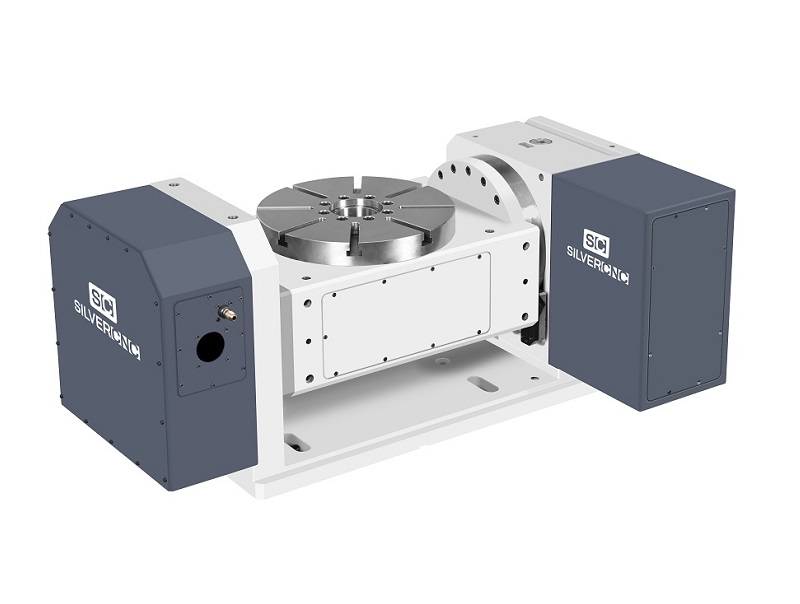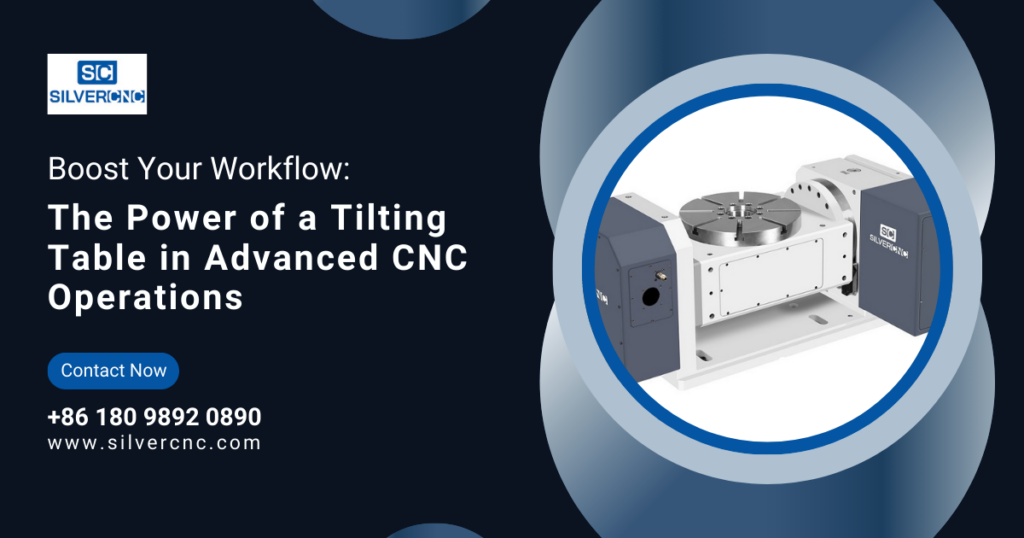
In the ever-evolving world of CNC machining, precision, speed, and flexibility are paramount. Whether you’re working with intricate parts, multi-axis machining, or tight tolerances, your equipment needs to provide optimal results while minimizing downtime and human error. Enter the tilting table—a highly efficient tool that has become a game-changer in advanced CNC operations.
A tilting table is a versatile component used to hold and rotate workpieces at precise angles during machining processes. Unlike traditional flat tables, tilting tables offer dynamic positioning capabilities, allowing your CNC machine to access the part from multiple angles without manual repositioning. This ability to tilt the workpiece can significantly enhance your machining capabilities, improve productivity, and streamline your workflow.

Understanding the Tilting Table: A Key CNC Component
Before delving into the various advantages of using a tilting table, it’s important to understand exactly what it is and how it functions. A tilting table is typically a rotating fixture mounted on a CNC machine that allows workpieces to be tilted at various angles for machining. It works in tandem with the machine’s axis, giving the operator the flexibility to perform multiple operations on a single part from different angles.
The key feature of a tilting table is its ability to rotate the workpiece along one or more axes, allowing for precise adjustments that are crucial for complex machining. This flexibility is invaluable when working with multi-axis machining tasks, where parts must be accessed from multiple orientations to achieve the desired finish.
The Advantages of Using a Tilting Table in CNC Operations
1. Simplified Multi-Axis Machining
One of the primary advantages of a tilting table is its ability to simplify multi-axis machining. Traditional setups often require the operator to manually reposition the workpiece to access different faces or angles, which can be time-consuming and prone to errors. A tilting table eliminates this issue by providing a dynamic rotation system that can tilt the part to the necessary angles automatically.
With a tilting table, CNC machines can perform multi-axis machining tasks in one continuous setup. Whether you’re machining complex geometries, drilling holes at precise angles, or milling intricate designs, the tilting table ensures your workpiece remains in place while the machine performs multiple operations from different orientations. This significantly shortens the time needed for setup and increases the quality of the machining overall.
2. Increased Precision and Accuracy
Precision is critical in CNC machining, and even small misalignments can lead to costly errors. A tilting table enhances accuracy by maintaining a stable, secure platform for your workpiece. With precise control over the tilting motion, the operator can position the workpiece with exact accuracy, minimizing the risk of misalignment.
This is especially important for industries such as aerospace, automotive, and medical device manufacturing, where tight tolerances are essential. The tilting table ensures that every angle is achieved with pinpoint precision, resulting in high-quality, repeatable parts with fewer defects.
3. Reduced Setup Time and Increased Efficiency
As with any manufacturing process, time is money. One of the most significant benefits of a tilting table is its ability to reduce setup time. By eliminating the need for manual repositioning of parts, the tilting table streamlines the entire process. The operator can load the workpiece onto the table, and the CNC machine can handle the rest, automatically adjusting the workpiece to the desired angles.
This reduction in setup time leads to a more efficient workflow and faster production cycles. Operators can spend less time adjusting and repositioning parts and more time on actual machining. As a result, machine utilization is maximized, and throughput increases.
4. Enhanced Workflow Flexibility
Another significant benefit of a tilting table is its flexibility. CNC machining tasks can vary greatly, and having a tool that can adapt to different types of operations is invaluable. Whether you’re working with simple, flat parts or more complex components with multiple faces and angles, a tilting table offers the versatility needed to tackle a wide range of projects.
With the ability to tilt the workpiece in multiple directions, the tilting table allows operators to perform a diverse array of operations, including drilling, milling, engraving, and more, all while maintaining a consistent position for the workpiece. This flexibility makes it easier to handle both standard and more advanced machining tasks.
5. Improved Tool Life and Reduced Wear
When machining parts with complex geometries or hard materials, tool wear can be a significant concern. The precision offered by a tilting table helps to mitigate this issue by ensuring that the cutting tools are aligned with the workpiece at the proper angles, reducing unnecessary wear and tear on the tools.
Additionally, the ability to maintain consistent cutting angles reduces the chances of uneven tool wear, which can result in suboptimal cutting conditions and compromised part quality. By maintaining proper tool alignment and extending tool life, the tilting table helps improve the overall efficiency of your machining operations.
6. Enhanced Safety and Stability
CNC machining often involves working with heavy or irregularly shaped parts, which can be difficult to handle. A tilting table improves safety by providing a stable, secure platform for the workpiece, reducing the need for manual handling, and minimizing the risk of accidents. The table securely holds the part in place, ensuring that it remains stationary during machining operations.
By providing a stable and controlled environment, the tilting table enhances the safety of both operators and equipment, reducing the chances of damage or injury during complex operations.
When to Invest in a Tilting Table
If you’re still considering whether a tilting table is a valuable addition to your CNC workshop, it’s important to assess your specific needs. A tilting table can significantly improve the efficiency and flexibility of your operations if:
- You frequently work with multi-axis parts or complex geometries.
- You need to perform operations from different angles or orientations.
- You want to reduce setup times and improve machining efficiency.
- You require high precision and accuracy in your machining processes.
- You are looking to enhance overall productivity and reduce tool wear.
For manufacturers seeking to streamline their workflow and enhance the capabilities of their CNC machines, a tilting table is a smart investment that can deliver long-term benefits. Whether you’re focused on improving production speed, reducing errors, or enhancing part quality, the tilting table provides the versatility and precision required to take your CNC operations to the next level.
The tilting table is a powerful tool that can dramatically improve your CNC machining workflow. By offering increased precision, flexibility, and efficiency, it helps manufacturers tackle complex machining tasks with ease. From reducing setup time to enhancing part accuracy, the tilting table is an indispensable asset for any CNC operation aiming to stay ahead in the competitive manufacturing landscape.
At SilverCNC, we understand the importance of high-quality equipment in achieving optimal results. Our tilting tables are designed to provide superior precision, reliability, and performance, ensuring that your CNC operations run smoothly and efficiently. With our advanced technology, you can unlock new possibilities and take your manufacturing processes to the next level.

FAQs
1. What is a tilting table, and how does it work?
A tilting table is a CNC accessory that holds and rotates the workpiece at precise angles, enabling multiple machining operations on the same part without manual repositioning. It provides greater flexibility for complex machining tasks.
2. How does a tilting table improve machining efficiency?
A tilting table reduces setup time, eliminates manual repositioning, and enhances precision, leading to faster production cycles and improved workflow efficiency.
3. Can a tilting table help with multi-axis machining?
Yes, a tilting table simplifies multi-axis machining by automatically positioning the workpiece at different angles, allowing for more complex operations in a single setup.
4. What types of operations can be performed with a tilting table?
A tilting table is versatile and can handle a variety of operations, including milling, drilling, engraving, and 3D machining, all from multiple orientations.
5. Why should I choose SilverCNC’s tilting tables?
SilverCNC offers high-precision, durable tilting tables that improve workflow efficiency, reduce setup time, and enhance machining precision, making them an excellent choice for advanced CNC operations.